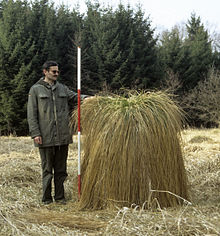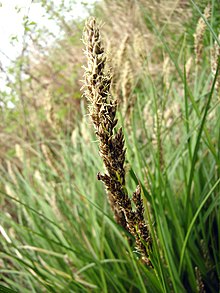Panicle sedge
| Panicle sedge | ||||||||||||
|---|---|---|---|---|---|---|---|---|---|---|---|---|

Panicle sedge ( Carex paniculata ), typical bult |
||||||||||||
| Systematics | ||||||||||||
|
||||||||||||
| Scientific name | ||||||||||||
| Carex paniculata | ||||||||||||
| L. |
The panicle sedge ( Carex paniculata ) is a species of the sour grass family (Cyperaceae). The type epithet is of Latin origin from paniculátus, -a, -um = panicle and refers to the panicle inflorescence.
description
The panicle sedge is a deciduous, perennial herbaceous plant . The hemicryptophyte forms 30 to 150 centimeters high and 1.5 meters in diameter, strong bultes or clumps with rich roots and very thick, dark brown roots. The standing main axis grows somewhat storied. The 60 to 150 centimeters long, sharp, triangular, very rough stems grow slightly arched overhanging. The flat, gray-green, coarse and stiff leaves are between 3 and 6 millimeters wide and up to 20 decimeters long. They are sharp and rough around the edges. The lowest leaf sheaths are light to black brown and do not have a tuft of fibers. The anterior vaginal walls of the upper leaf sheaths are tough, whitish and do not tear easily. The upper edge is slightly bulged downwards. The ligule is designed as a narrow, 2 to 5 millimeters wide border. The mouth of the vagina is circular.
The light brown, paniculate, rarely spiked, inflorescence has numerous spikelets on mostly several centimeters long, protruding branches. The inflorescence reaches lengths between 5 and 10 centimeters. The upper spikelets of the homosexual sedge consist of male flowers; the lower ones from single female flowers. The husks are pointed, light brown and with white margins. The light brown, obliquely protruding and shiny fruit sacs (utriculi) are between 2.5 and 3 millimeters long. The fruit beak is bidentate. The ovary bears two scars . The fruit is yellow-brown.
The chromosome number of the species is 2n = 60, 62 or 64.
ecology
This large sedge forms large and stately clumps ( Bulte or Bülte ) in wet and swampy locations .
The panicle sedge is a semi-light to shade plant . Their ecological focus is on seeping, low-nitrogen to moderately nitrogen-rich and base-rich tuff and peat soils in temperate climates. It is the characteristic of the plant community (association) of the pan sedge reed (Caricetum paniculatae). There it often grows together with the marsh sedge ( Carex acutiformis ), marsh bedstraw ( Galium palustre ) and shore wolfstrapp ( Lycopus europaeus ).
The main flowering time of the panicle sedge extends from May to June. Sometimes the sedge blooms as early as April. The flowers are pollinated by the wind. Water, wind, Velcro and self- propagation serve to spread the diaspores .
Occurrence
The panicle sedge occurs all over Europe, but is absent in the far north. It is also common in western Asia, Asia Minor and North Africa. It grows mainly in limestone areas of the lowlands and mountain areas up to altitudes of mostly 1750 meters above sea level . In the Allgäu Alps, it rises in the Kleiner Walsertal between Kanzelwand and Kuhgehrenspitze up to 1900 m above sea level.
It settles scattered but socially in the great sedge, especially in the silting area of moderately nutrient-rich to nutrient-rich (meso- to eutrophic) still waters, at springs, in ditches as well as in alder quarries and riparian forests .
Subspecies and their distribution, hybrids
The following subspecies are distinguished:
- Carex paniculata subsp. calderae ( A.Hansen ) Lewej. & Lobin ; Canary Islands ( Tenerife )
- Carex paniculata subsp. hansenii Lewej. & Lobin : Cape Verde Islands
- Carex paniculata subsp. lusitanica ( Willd. ) Maire : western Mediterranean area
- Carex paniculata subsp. paniculata : Europe, Western Asia ( Caucasus ), North Africa ( Morocco )
- Carex paniculata subsp. szovitsii ( VIKrecz. ) Ö.Nilsson : Crimea , north-eastern Turkey, West Caucasus.
The panicle sedge and the angle sedge ( Carex remota ) form the hybrid Carex × boenninghauseniana Kunth . Furthermore, hybrids with the blackhead sedge ( Carex appropinquata ) (= Carex × solstitialis Figert ), the grove sedge ( Carex otrubae ), the gray sedge ( Carex canescens ), the wire sedge ( Carex diandra ), the hedgehog sedge ( Carex echinata ), the roller sedge ( Carex elongata ) and the fox sedge ( Carex vulpina ).

swell
literature
- A. Petersen: The sour grasses. Akademie-Verlag, Berlin, 1989.
- Jürke Grau , Bruno P. Kremer, Bodo M. Möseler, Gerhard Rambold, Dagmar Triebel: Grasses. Sweet grasses, sour grasses, rushes and grass-like families in Europe (= Steinbach's natural guide ). New, edit. Special edition edition. Mosaik, Munich 1996, ISBN 3-576-10702-9 .
- Henning Haeupler, Thomas Muer: picture atlas of the fern and flowering plants of Germany . Ed .: Federal Agency for Nature Conservation (= The fern and flowering plants of Germany . Volume 2 ). Eugen Ulmer, Stuttgart (Hohenheim) 2000, ISBN 3-8001-3364-4 .
- Erich Oberdorfer : Plant-sociological excursion flora . With the collaboration of Theo Müller. 7th, revised and expanded edition. Eugen Ulmer, Stuttgart (Hohenheim) 1994, ISBN 3-8252-1828-7 .
Individual evidence
- ^ Erich Oberdorfer : Plant-sociological excursion flora for Germany and neighboring areas . With the collaboration of Angelika Schwabe and Theo Müller. 8th, heavily revised and expanded edition. Eugen Ulmer, Stuttgart (Hohenheim) 2001, ISBN 3-8001-3131-5 , pp. 175 .
- ↑ Erhard Dörr, Wolfgang Lippert : Flora of the Allgäu and its surroundings. Volume 1, IHW, Eching 2001, ISBN 3-930167-50-6 , p. 249.
- ↑ Rafaël Govaerts (ed.): Carex paniculata. In: World Checklist of Selected Plant Families (WCSP) - The Board of Trustees of the Royal Botanic Gardens, Kew . Retrieved January 10, 2016.
- ^ AC Jermy, TG Tutin: Sedges of the British Isles. Botanical Society of the British Isles, London, 1982, ISBN 0-901158-05-4 .
Web links
- Panicle sedge. In: FloraWeb.de.
- Panicle sedge . In: BiolFlor, the database of biological-ecological characteristics of the flora of Germany.
- Profile and distribution map for Bavaria . In: Botanical Information Hub of Bavaria .
- Carex paniculata L. In: Info Flora , the national data and information center for Swiss flora .
- Distribution in the northern hemisphere from: Eric Hultén, Magnus Fries: Atlas of North European vascular plants. 1986, ISBN 3-87429-263-0 at Den virtuella floran. (swed.)
- Thomas Meyer: Data sheet with identification key and photos at Flora-de: Flora von Deutschland (old name of the website: Flowers in Swabia )

